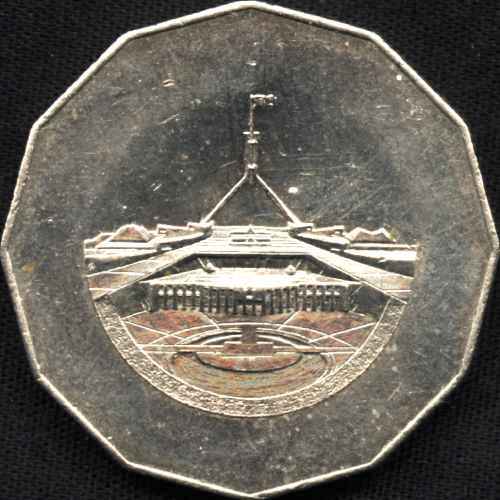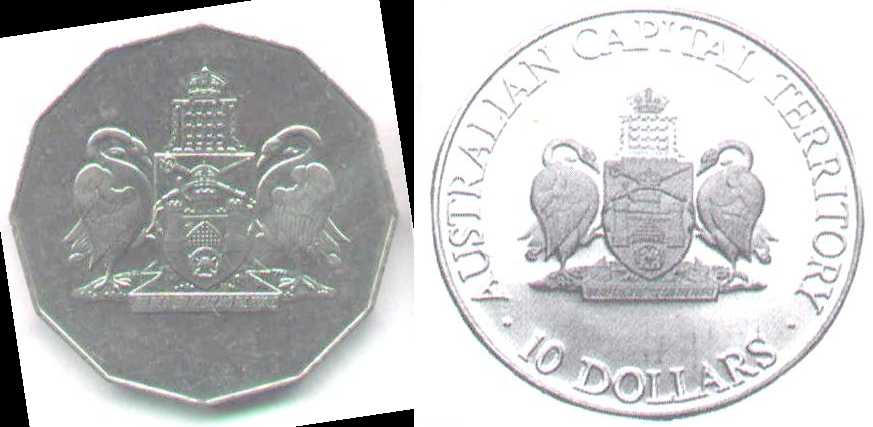

|
|
Considerable interest has been sparked in the numismatic community by the appearance
of several specimens of the "coin" shown below. At least 13 can be accounted
for but the number in existence is probably a little larger, perhaps as many as
20.
There is no clear distinction between obverse and reverse on this coin and it
may even be said to show two reverses. The specimen was struck on a dodecagonal
50c planchet.
One side shows the ACT Coat of Arms and features two swans supporting a shield
which shows a crown over sword and sceptre above a castle gate with portcullis and
a stylised rose. Above the shield is another crown supported on something which
I don't recognise. (Anyone out there familiar with heraldic devices?) This side
was identified by Said Diviny of SVC Collectables and confirmed by a search for
"Coat
of Arms" in the A.C.T. Government web
pages.
The other side shows the new Federal Parliament House in Canberra.
 |
Nominal obverse depicting the ACT Coat of Arms. Motto reads "FOR THE QUEEN,
THE LAW AND THE PEOPLE." |
 |
Nominal reverse featuring a representation of the new Australian parliament house
on Capital Hill, Canberra. |
This item was almost certainly a product of the Royal Australian Mint in Canberra
but according to officers of the Mint there are no records of this piece having
been struck. There is a hypothesis that the "coin" was struck as a commemorative
piece for sale at the kiosk in the new Parliament House building but even if that
were so, none was ever distributed via that channel. In any case, one would have
expected some sort of legend to identify the occasion. More importantly, the
Royal Australian Mint would never allow a medallion to be struck on the planchet
of a legal tender coin.
The specimen shown here is gEF or aU. One of these coins in somewhat better condition
was sold in Melbourne a few years ago for AUD$2100 and another was recently sold
by Downies (also in Melbourne) for $1610 (see the April 2000 edition of Australian
Coin Review). This specimen is one of twelve that turned up in a box of junk in
England and was advertised on eBay by Lockwood Coins. The other eleven have since
been sold. I do not know if the one sold in April was one of them.
The the dealer who found the twelve specimens supplied the following description
to Lockwood Coins based on his own research:
Australia Pattern 50c duodecagonal in cupro-nickel obverse Parliament House with flag raised reverse Coat of Arms over "FOR THE QUEEN, THE LAW AND THE PEOPLE", EF as yet unlisted and extremely rare (the only other example we can trace ever being offered was lot 1472 in the Spink Noble Auction of 1994 est, $A250 realised $A2100)Two other coins have depicted the new Parliament House. One was a silver dollar coin issued in 1998 to mark the tenth anniversary. I have not seen one of those but judging by the picture in McDonald's catalogue the representation of Parliament House is similar (but by no means identical) to that on the mystery coin. The earlier coin was a $5 issued in 1988 to mark the opening and any resemblance between the design on that one and the mystery coin is purely superficial.
Update: 22 June 2000
A collector in Queensland has compared the "pattern" specimen
with the 1998 silver dollar issued to mark the tenth anniversary of the opening
of the new Parliament House, and with the $10 ACT "State series" coin
of 1993. According to Shane, the depiction of the ACT Coat of Arms is an exact match
with that on the 1993 $10 coin. Judging by the picture Shane sent me, the CoA on
the $10 is slightly smaller than that on the pattern piece but otherwise the two
do seem to be identical. I shall be in a position to confirm this in a couple of
weeks.
 |
Again according to my correspondent's investigations the design on the Parliament House
side of the pattern specimen is just like that on the 1998 $1 coin, the two designs
being exactly the same size. The "garden" area was cut from the pattern
and replaced on the $1 with a reduced image of the 1988 $5 coin (shown below). When
I attempted to confirm this observation I found several small but significant differences:
|
The 1998 commemorative $1 proof coin shows less detail than the pattern piece. Both
coins bear Horst Harne's initials but whereas on the pattern piece the initials
are over on the far left, on the $1 they are on the right. |
Update: April 2001
Late last year I obtained a second specimen from a dealer in Canada who in turn
had obtained it from a dealer in England. The information here is as reported by
David Bergeron, the Canadian, in e-mail correspondence dated 4th Jan 2001:
Sorry I completely forgot to get in touch with you. Thanks for reminding me. I happen[ed] to see the dealer who sold me the coin at the Sotheby's auction last November. He remembers the piece, but he told me that it was a coin he had purchased a while back and had almost forot he owned it. He told me that it was a fabrication of the Royal Mint that was strictly used to test the striking properties of the die and not necessarily to present a new design. He could not confirm where the dies came from, nor who designed them, but he believes that they were made by a private mint based in London. That's about all he could tell me. It really doesn't tie up any loose ends except for the fact that the pattern piece is struck in England and not in Australia. If I find out anything else I'll let you know.
 |
1988 $5 in aluminium bronze. Design by Stuart Devlin. |